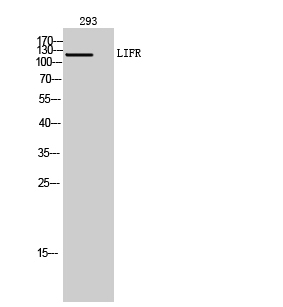产品名称
LIFR Rabbit Polyclonal Antibody
别名
LIFR; Leukemia inhibitory factor receptor; LIF receptor; LIF-R; CD118
蛋白名称
Leukemia inhibitory factor receptor
存储缓冲液
Liquid in PBS containing 50% glycerol, 0.5% BSA and 0.02% New type preservative N.
Human Gene Link
http://www.ncbi.nlm.nih.gov/sites/entrez?db=gene&term=3977
Human Swissprot No.
P42702
Human Swissprot Link
http://www.uniprot.org/uniprotkb/P42702/entry
Mouse Gene Link
http://www.ncbi.nlm.nih.gov/sites/entrez?db=gene&term=
Mouse Swissprot No.
P42703
Mouse Swissprot Link
http://www.uniprot.org/uniprot/P42703
Rat Gene Link
http://www.ncbi.nlm.nih.gov/sites/entrez?db=gene&term=
Rat Swissprot Link
http://www.uniprot.org/uniprot/
免疫原
The antiserum was produced against synthesized peptide derived from the Internal region of human LIFR. AA range:731-780
特异性
LIFR Polyclonal Antibody detects endogenous levels of LIFR protein.
稀释度
WB 1:500-2000;IHC-p 1:50-300; ELISA 2000-20000
宿主
Polyclonal, Rabbit,IgG
背景介绍
leukemia inhibitory factor receptor alpha(LIFR) Homo sapiens This gene encodes a protein that belongs to the type I cytokine receptor family. This protein combines with a high-affinity converter subunit, gp130, to form a receptor complex that mediates the action of the leukemia inhibitory factor, a polyfunctional cytokine that is involved in cellular differentiation, proliferation and survival in the adult and the embryo. Mutations in this gene cause Schwartz-Jampel syndrome type 2, a disease belonging to the group of the bent-bone dysplasias. A translocation that involves the promoter of this gene, t(5;8)(p13;q12) with the pleiomorphic adenoma gene 1, is associated with salivary gland pleiomorphic adenoma, a common type of benign epithelial tumor of the salivary gland. Multiple splice variants encoding the same protein have been found for this gene. [provided by RefSeq, Jul 2008],
组织表达
Hippocampus,Placenta,
细胞定位
[Isoform 1]: Cell membrane; Single-pass type I membrane protein.; [Isoform 2]: Secreted.
信号通路
Cytokine-cytokine receptor interaction;Jak_STAT;
功能
disease:A chromosomal rearrangement involving LIFR may be a cause of salivary gland pleiomorphic adenomas (PA) [181030]. Pleiomorphic adenomas are the most common benign epithelial tumors of the salivary gland. Translocation t(5;8)(p13;q12) with PLAG1.,disease:Defects in LIFR are the cause of Stueve-Wiedemann syndrome (SWS) [MIM:601559]; also called Schwartz-Jampel syndrome type 2 or SJS2. SWS is a severe autosomal recessive condition and belongs to the group of the bent-bone dysplasias. SWS is characterized by bowing of the lower limbs, with internal cortical thickening, wide metaphyses with abnormal trabecular pattern, and camptodactyly. Additional features include feeding and swallowing difficulties, as well as respiratory distress and hyperthermic episodes, which cause death in the first months of life. The rare survivors develop progressive scoliosis, spontaneous fractures, bowing of the lower limbs, with prominent joints and dysautonomia symptoms, including temperature instability, absent corneal and patellar reflexes, and smooth tongue.,domain:The box 1 motif is required for JAK interaction and/or activation.,domain:The WSXWS motif appears to be necessary for proper protein folding and thereby efficient intracellular transport and cell-surface receptor binding.,function:Signal-transducing molecule. May have a common pathway with IL6ST. The soluble form inhibits the biological activity of LIF by blocking its binding to receptors on target cells.,similarity:Belongs to the type I cytokine receptor family. Type 2 subfamily.,similarity:Contains 6 fibronectin type-III domains.,subunit:Heterodimer composed of LIFR and IL6ST. The heterodimer formed by LIFR and IL6ST interacts with the complex formed by CNTF and CNTFR.,
纯化
The antibody was affinity-purified from rabbit antiserum by affinity-chromatography using epitope-specific immunogen.

